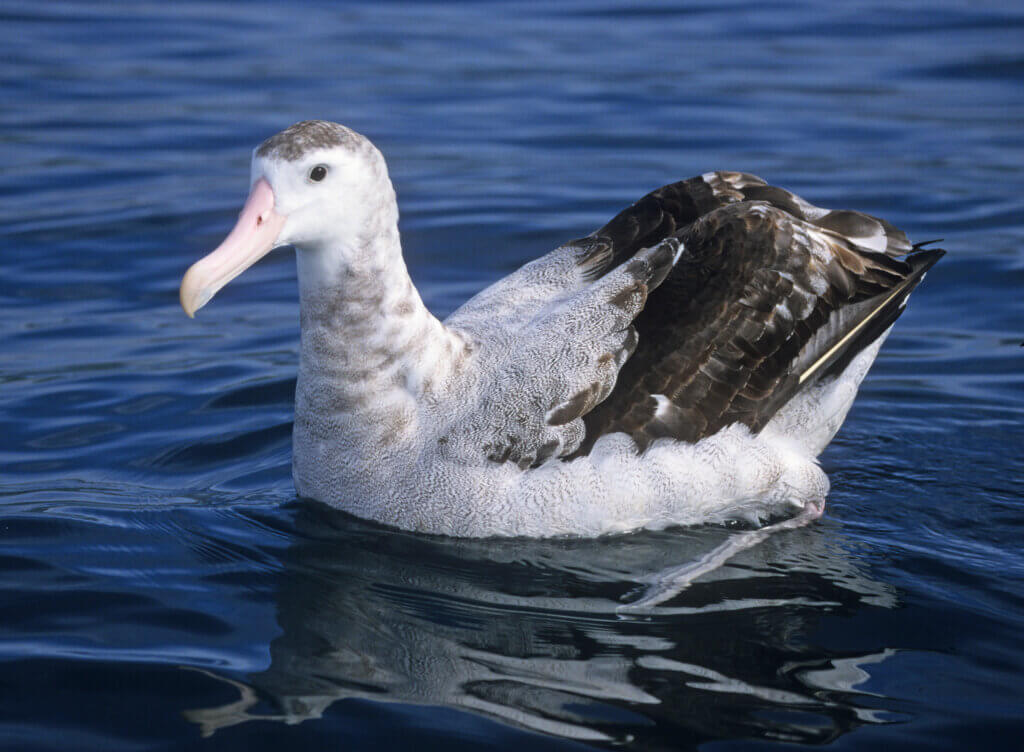
Guy writes: as a young boy interested in birds, albatrosses, being birds mainly of the southern hemisphere, always had something of a mystical status to me. From school, I remember an English Literature lesson covering the ‘The Rime of the Ancient Mariner’ by Samuel Coleridge. This lengthy poem revolves around the killing of an albatross and the deadly repercussions for the crew of the ship. There is some salvation for the mariner who survives as a wiser man appreciating the value of nature. The resulting phrase of ‘an albatross around one’s neck’ has become an idiom referring to carrying a heavy burden of guilt. The impact of killing just one bird in this poem perhaps carries some analogy for mankind, when you consider the devastating death toll we have taken on these amazing birds, and the collective guilt society has to bear for pushing some species towards extinction.
Under current taxonomy there are 22 albatross species, of which 17 are Globally Threatened on the IUCN Red List. Seabirds, particularly albatrosses, are becoming increasingly threatened and at a faster rate globally than all other species-groups of birds. The first albatross I saw was in 1986 on an ornithological pilgrimage to Hermaness on the northernmost headland of Unst in Shetland. After incurring the wrath of dive bombing bonxies, we looked down from the high cliff on one rather lonely looking black-browed albatross sitting within a huge gannet colony. Since then I’ve been lucky to see another six species, but the one that made the biggest impression was this up close and personal Antipodean albatross (now split from the very similar Wandering albatross) from a boat off Kaikoura in New Zealand back in 2001. The sheer size of the bird was a little overwhelming.
Sadly, albatrosses and many other seabirds continue to face a wide variety of threats from human activity. Many declines are closely linked to the expansion of commercial longline fisheries and modern industrial fishing methods are threatening to drive almost three quarters of all albatross species towards extinction. The global scourge of plastic in our oceans has been brought sharply into focus with pitiful decaying corpses of albatross chicks revealing the huge number of deadly plastic items inadvertently fed to them by their parents. This was highlighted on the BBC Blue Planet series. At some breeding sites, like Gough Island in the South Atlantic, they also face the impacts of invasive alien species at nesting colonies with gruesome images of oversized mice eating chicks. RSPB are currently engaged in an ambitious huge rodent eradication programme to help the critically endangered Tristan albatross and many other seabirds. This will be money well spent and people can support this work directly.
Thankfully, there is some amazing work being done around the planet. In 2005, BirdLife and the RSPB set up the Albatross Task Force (ATF) – an international team of bycatch prevention experts working alongside governments, communities and fishers on board their vessels to save seabirds in some of the deadliest fisheries across the world. A variety of clever innovations, such as Hookpod, are being developed and used to help reduce bycatch. The ATF website details some of the utterly inspiring work that has been done in the last 15 years saving hundreds of thousands of albatrosses and other seabirds. Most recently it was announced that after more than a decade of work with the country’s fishing industry, the ATF in Namibia are celebrating a major conservation success. A new paper shows that seabird deaths in the Namibian demersal longline fishery have been reduced by 98%, equating to 22,000 birds saved every year.
Hopefully, like the original mariner in Coleridge’s classic poem, we can learn the necessary lessons to appreciate the importance of protecting these wonderful birds and not have to ultimately carry with us the guilt of their extinction.
Image taken with Canon T90 with a Canon 100-400 L lens on Fujicrome Velvia 100.
[registration_form]
A cracking photograph of a special bird, but then aren’t all birds brilliant.
As there are so many bird experts here: can the woodpigeon on one side of my garden recognise the individual woodpigeon 10 or 20 meters away? Does it know it is ‘Fred’ (who bosses him when they get close) or ‘George’ (who he chases off)?
Birds obviously seem to be able to recognise other individuals up close – unlike most of our recognition of them. Otherwise my example is wasting his time displaying to ‘Susan’, as she may turn out to be George, who certainly won’t be able to have his eggs.
I don’t know enough of the right terminology to be able to look the question up on the web. Can anyone help?